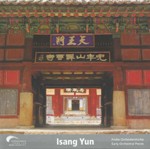3(II,III=picc).3.0.bcl.3(III=dbn)-4.0.3.1-timp.perc(6):6gong(lo)/12hand bell/6tom-t/6tgl/3BD/3bell bundle/3tam-t(lo)/SD/TD/5susp.cym/6Thai.gong/tamb(lg)/6maracas-strings(0.0.8.6.4)
Abbreviations (PDF)
Bote & Bock
According to Yun’s friend, publisher, and librettist Harald Kunz, the composer began writing down Dimensions in the middle of July and concluded his work on the score on September 21, 1971, in Groß-Glienicke near Berlin. Even before Dimensions, also parallel to the opera, he completed the score of Namo for three sopranos and full orchestra in Berlin on March 16, 1971. A little later the premiere was held in the main broadcast studio of the SFB.
At the time the following work introduction found its way into print under Yun’s name, "The title Namo comes from the Sanskrit and means ‘greeting’. It is derived from prayers of Mahªyªna Buddhism, which were employed freely as a textual basis: Saddharmapun'd'arÌka, Mahªyªnasñtrasamgraha, Sªdhanamªlª. The three sopranos beat drums like Buddhist nuns or like shamans during a ceremony. This combination of the singing voice and instrument and the recital intensifying to ecstasy over the course of the work are the only musical elements of the composition drawing on Far Eastern models. It is otherwise completely freely designed. The work consists of four sections, each of five to seven parts, resulting from the structuring of the text. The parts are linked by purely instrumental inserts, above all by percussion accents. Within the sections the three parallelly led voice parts and instrumental groups such as woodwinds, brass instruments, percussion, and low strings form closely related tone groups in the form of longh-held notes, so-called main tones. These have the effect of units, even though they constantly change their inner structure through the exchange of voices, embellishments, glissandi, and pre-beats, post-beats, and inter-beats."
Dieter Eikemeier and Mirella Lingorska stated of the text of Namo (in Ssi-ol. Almanach 2002/03 der Internationalen Isang Yun Gesellschaft): "The short text ... combines in eclectic fashion greeting formulas, holy words (mantra), and canonic teaching (sñtra), the latter, however, in a form slightly changed over against the canonic texts. One or the other among the textual references goes back to various developmental stages of Buddhism." The interconnection of these different texts forms "a large display of Buddhist pictorialness spanning several epochs and cultures without, however, being constructed chronologically and without producing a dogmatic effect."
In Namo Yun designs an atmosphere gradually ascending in a spiral from inconspicuous beginnings. This atmosphere extends to ecstatic transport and in part also plays a role in the opera Sim Tjong. Yun paid particular attention to the formulation of the three voice parts interrelated in the manner of a heterophonic sound band. The execution of these closely interlocked parts requires virtuoso, experienced high sopranos whose voice character is also harmonized in sound colour.
Syncretism is what at first glance stands out in the design of Namo. Three female singers represent shamans who sing themselves into ecstasy with Buddhist greeting formulas, holy words, and canonic teachings. Each of the singers beats a drum (if possible of different sizes) while singing; here chwago drums, a Sino-Korean instrument playing a role in royal ancestral music and Confucian shrine music and occasionally also in Buddhist ceremonies, have become customary. The singers are accompanied by a full-size European symphony orchestra without violins but with an unusually extensive arsenal of percussion instruments requiring at least six players. Aesthetically, the syncretistic idea has the advantage of a mostly highly original design, and Yun irreversibly blended together all the oppositions in his own individual personal style in its realization.
The careful setting of the Buddhist text is central. From an esoteric perspective, the introductory formula "(om) namo buddhªya" in no way means "Greetings to Buddha!" but "Become one with Buddha!" and for the meditating individual even "Be Buddha!" The text can be divided into five sections, A, B, C, D, and E, with the caesuras occurring in each case after lines 3, 6, 12, and 16. (When Yun himself spoke of four parts, then he presumably considered the first two parts as a unit.) After a dark instrumental introduction (with the bass clarinets and other instruments), the setting begins relatively slowly and quietly in a low register; Yun sets off the lines of the text with bells and other bright metallic percussion instruments. In the second part, which is introduced by the oboe, Yun intensifies the dramatic tension to a first high point, "jinam vandamo" [We greet the victor].
After a powerful interlude the considerably more extensive sections C and D (or A’ and B’) have the effect of a new beginning on an extended degree scale. The quiet of the greeting formulas recited respectfully in Sprechgesang undergoes a dramatic change with the address to Avalokiteívara, the perceiver of the cries of the world, the Bodhisattva of boundless mercy and sympathy, and Prajñaparamita, the goddess of perfect wisdom, in the high and highest regions. Section D is almost six minutes in duration (of a total of twenty minutes, which makes it the most extended and also the most intensive section). Its text "ye dharma hetuprabhava ..." [Of everything that has an origin ...] contains, as Dieter Eikemeier and Mirella Lingorska indicate, together with the most important and also certainly the oldest layer, at the same time also the reference to the origin and end of all suffering. The last section of the Buddhist vocal work functions as a return from the greatest excitement and extreme ranges.
Walter-Wolfgang Sparrer (2004, translated by Susan Marie Praeder)

Dorothy Dorow, Maria de Francesca, Slavka Taskova (sopranos) / Radio-Symphonie-Orchester Berlin / Michael Gielen
Internationale Isang Yun Gesellschaft IYG 003
